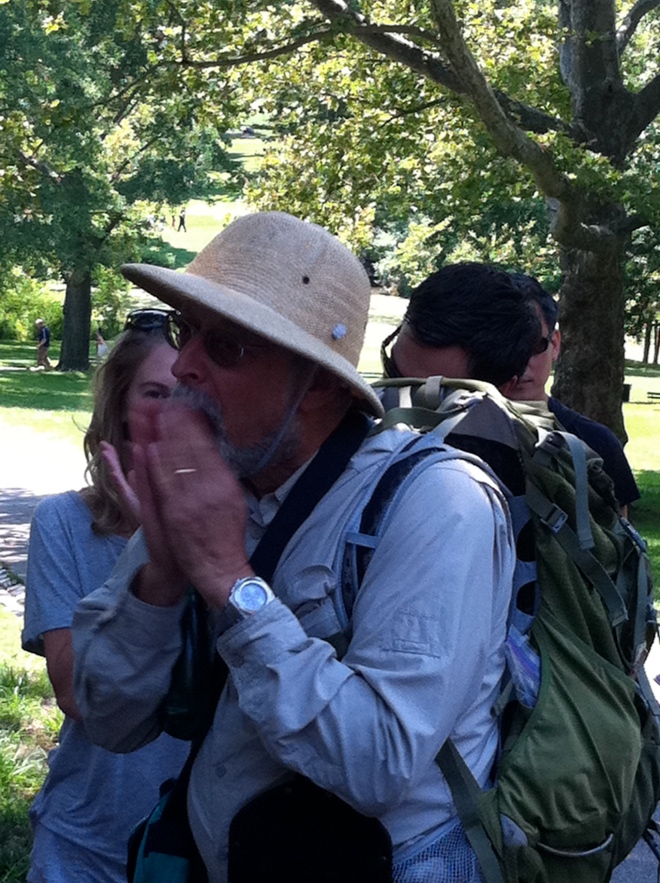WOW. July has been busy, busy busy – in the garden and out!
I am way behind on posting here at Red Garden Clogs as well as keeping up with all the other blogs I love to check in on. I even missed Garden Bloom Day!
My husband and I had a few family visits and then we went on a beach-camping trip to Fire Island, which is a very long and narrow strip of marsh and gorgeous beach off of Long Island, NY. If you haven’t been there before and can get there, GO. No cars allowed, nature “boardwalks” built in throughout the marshes and dunes, and some of the most beautiful and quiet beaches around these parts. Watch Hill has a fantastic small campground there, and the mosquitoes were NOT as bad as I’d been told to expect – ha.
But I digress. In an effort to catch up, I’m rewinding two weeks to the fantastic wild edibles foraging tour of Central Park that I got to take with fellow blogger Mimi over at Gardening in the Boroughs of NYC . Thanks again for the ticket, Mimi! (She has a great post about this tour and you can read it HERE.)
The tour was given by “Wildman” Steve Brill , a naturalist who has been hosting wild edible plant tours all over NY and CT since 1982!
Steve is *highly* entertaining (a bit of a comedian, really) – especially with kids, and there were many kids along for the ride. In fact, there were a lot of people on this tour! I had expected there to be maybe 6 or 7 of us – maybe a dozen tops… but I know there were somewhere around 40 altogether. Armed with spades, bags for plants, gardening gloves and bug spray, we all made our way through the park with Steve, who proceeded to point out, pick, and give a lesson about many edible and/or medicinal plants we found along the way.
The tour lasted about 4 hours, including a lunch break, and was really fun and VERY educational. I learned a lot and I was especially excited to discover that several of the “weeds” in my yard are edible! I also appreciated that Steve was careful not to take too many plants or to harvest only the tops of some so that they can continue to grow.
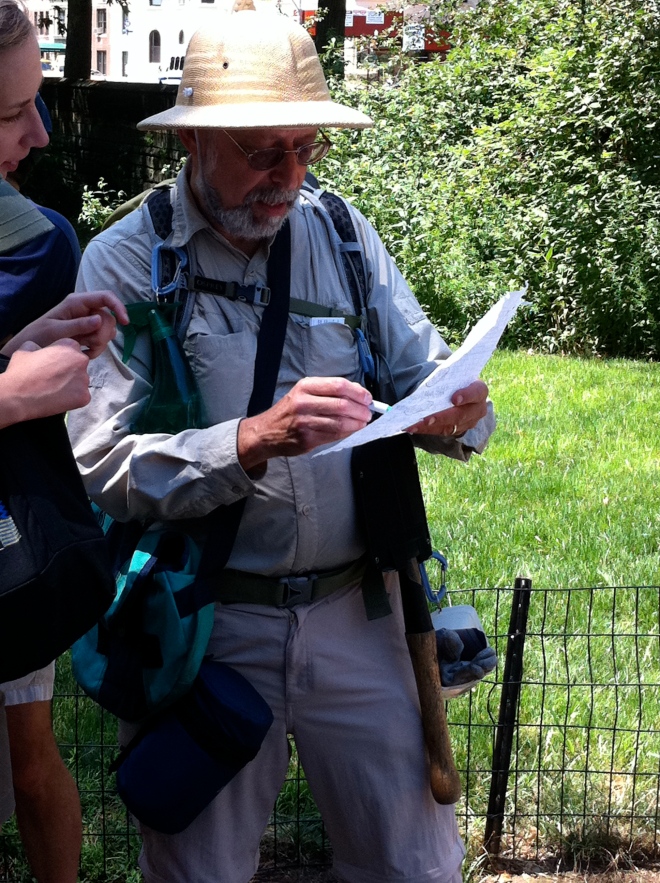 Here’s Steve, decked out in full foraging regalia right down to the safari hat, knife, and spade.
Here’s Steve, decked out in full foraging regalia right down to the safari hat, knife, and spade.
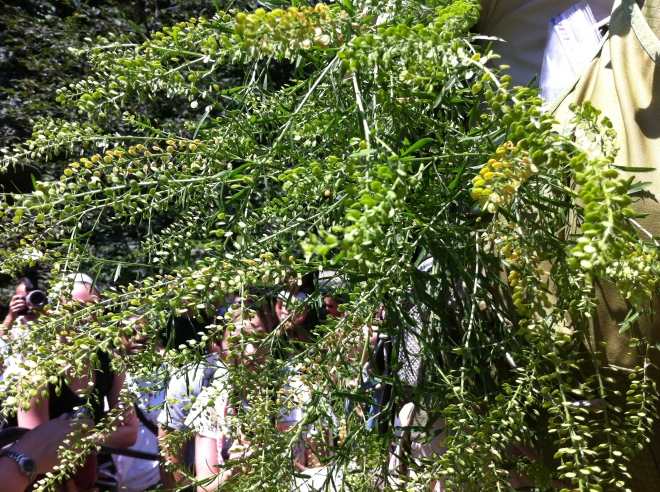 The first edible plant we came across was Poor Man’s Pepper.
The first edible plant we came across was Poor Man’s Pepper.
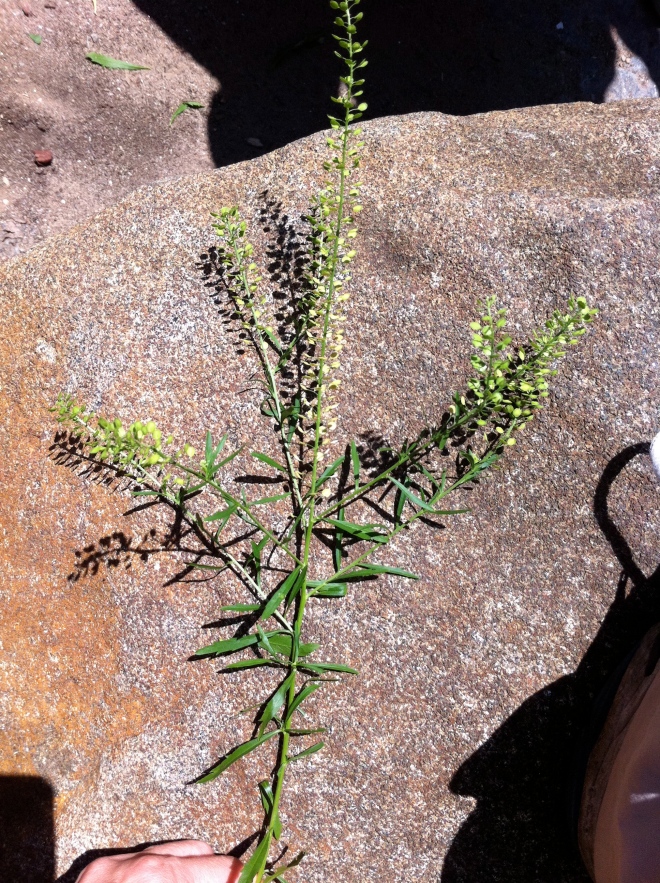 Here’s a close up of it. The green leaves that resemble tarragon are the part of the plant that is edible. The light green / yellow parts at the top of each stem are the seeds. Poor Man’s Pepper lives up to its name – the leaves have a nice peppery bit and were delicious! I think they’d be great added to a salad or soup, or maybe a quiche!
Here’s a close up of it. The green leaves that resemble tarragon are the part of the plant that is edible. The light green / yellow parts at the top of each stem are the seeds. Poor Man’s Pepper lives up to its name – the leaves have a nice peppery bit and were delicious! I think they’d be great added to a salad or soup, or maybe a quiche!
Lamb’s Quarters was the next plant we found. It has a great, spinach-y taste and sounds like it would also be good in salad, or steamed / sauteed and added to all kind of things. Watch our for the bird poop on this one! Steve made sure that we were only breaking of stems of plants that we sampled rather than pulling it up by the root.
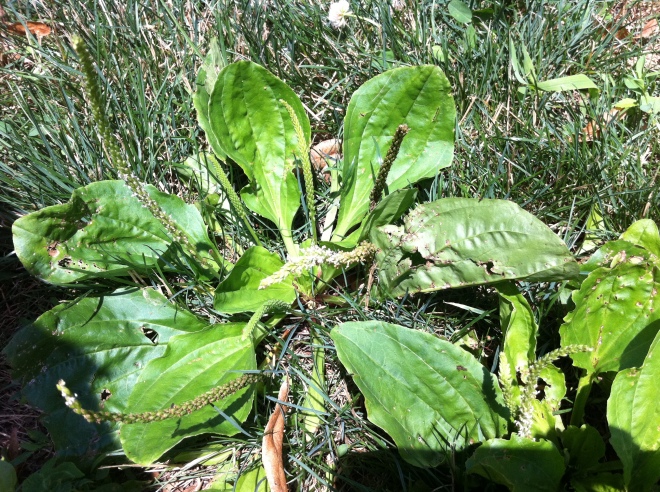 Plantain, above, grows ALL OVER my yard. And guess what it’s great for – mosquito bites! Who knew? Let me tell you, my ears perked up when Steve mentioned this use for the plant – it was music to my ears indeed. I am one of those people who mosquitoes really, really like. Steve said as soon as you get a bite to tear a leaf off the Plantain and rub it on the bite. He says if you do this a few times (using a fresh leaf each time) within the first 15 minutes of being bitten, your bite won’t itch and swell up. You can bet I’ll be trying this out while I’m getting bitten in the garden!
Plantain, above, grows ALL OVER my yard. And guess what it’s great for – mosquito bites! Who knew? Let me tell you, my ears perked up when Steve mentioned this use for the plant – it was music to my ears indeed. I am one of those people who mosquitoes really, really like. Steve said as soon as you get a bite to tear a leaf off the Plantain and rub it on the bite. He says if you do this a few times (using a fresh leaf each time) within the first 15 minutes of being bitten, your bite won’t itch and swell up. You can bet I’ll be trying this out while I’m getting bitten in the garden!
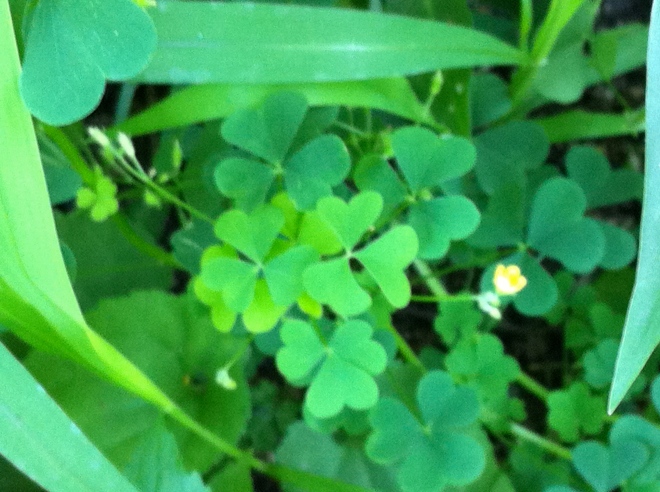 Sorry for this blurry picture. I just couldn’t get a good one with my phone. This is Wood Sorrel, and it has the most tart and tangy, delicious lemony flavor. I grew up eating this stuff in our backyard. You can tell it’s not clover because Wood Sorrel has heart-shaped leaves, not smooth ones. It also has little yellow flowers. Delightful!
Sorry for this blurry picture. I just couldn’t get a good one with my phone. This is Wood Sorrel, and it has the most tart and tangy, delicious lemony flavor. I grew up eating this stuff in our backyard. You can tell it’s not clover because Wood Sorrel has heart-shaped leaves, not smooth ones. It also has little yellow flowers. Delightful!
 The next edible plant we came across was Burdock, above…however you want the root of this biennial plant in its FIRST year, not in its SECOND year, as it appears above, with its lovely purple burrs. Later on we found young Burdock, in its first year, and several of us were able to dig up the plant to take the root home. The root can be used to flavor rice or soup. It was hard to dig up theses plants…a shovel is required!
The next edible plant we came across was Burdock, above…however you want the root of this biennial plant in its FIRST year, not in its SECOND year, as it appears above, with its lovely purple burrs. Later on we found young Burdock, in its first year, and several of us were able to dig up the plant to take the root home. The root can be used to flavor rice or soup. It was hard to dig up theses plants…a shovel is required!
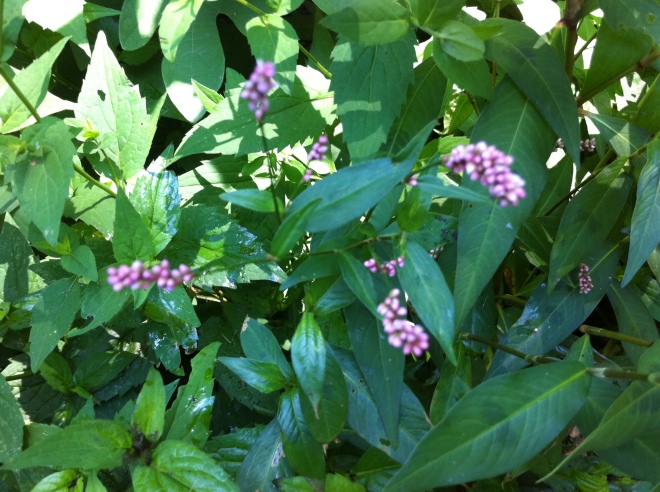 This lovely plant is called Lady’s Thumb because of the “thumbprints” it has on each leaf – if you look at the leaf in the lower right corner you can see two “thumbprints” in the middle. The leaves of this plant are edible and are supposed to taste like lettuce. The flavor was really mild. The nutritious leaves can be used in salads, added to sandwiches, or sauteed. We’ve been enjoying this plant in our yard for its pretty pink flowers and its habit of loosely spilling over a border.
This lovely plant is called Lady’s Thumb because of the “thumbprints” it has on each leaf – if you look at the leaf in the lower right corner you can see two “thumbprints” in the middle. The leaves of this plant are edible and are supposed to taste like lettuce. The flavor was really mild. The nutritious leaves can be used in salads, added to sandwiches, or sauteed. We’ve been enjoying this plant in our yard for its pretty pink flowers and its habit of loosely spilling over a border.
 Here’s Steve holding up a leaf from a Sassafrass. The root of Sassafrass is used for making root beer, and when you scraped away at the soft outer layer of the root, that’s pretty much exactly what it smelled like…kind of spicy and delicious.
Here’s Steve holding up a leaf from a Sassafrass. The root of Sassafrass is used for making root beer, and when you scraped away at the soft outer layer of the root, that’s pretty much exactly what it smelled like…kind of spicy and delicious.
 Here’s a better look at the Sassafrass leaves, many of which have that asymmetrical, “notched” appearance like the one smack in the middle of this photo. The leaves of Sassafrass can be dried and then ground up and added to soup as a thickener. Who knew?
Here’s a better look at the Sassafrass leaves, many of which have that asymmetrical, “notched” appearance like the one smack in the middle of this photo. The leaves of Sassafrass can be dried and then ground up and added to soup as a thickener. Who knew?
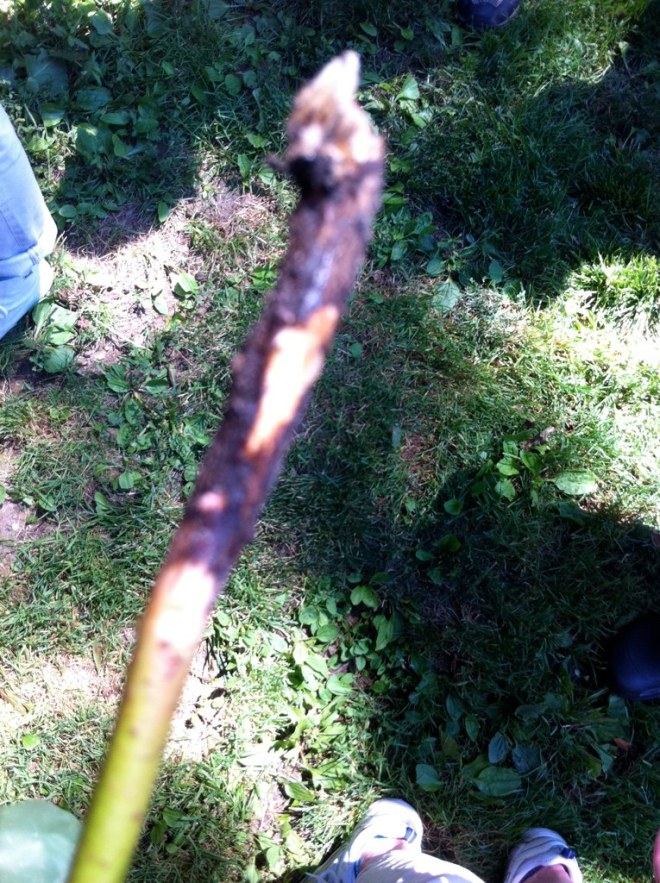 Another bad phone photo, but here’s the only shot I got of the Sassafrass root – you want the part under the dark layer. Evidently you can boil this and make a nice tea or you can boil it down and make a flavored syrup to add to carbonated water.
Another bad phone photo, but here’s the only shot I got of the Sassafrass root – you want the part under the dark layer. Evidently you can boil this and make a nice tea or you can boil it down and make a flavored syrup to add to carbonated water.
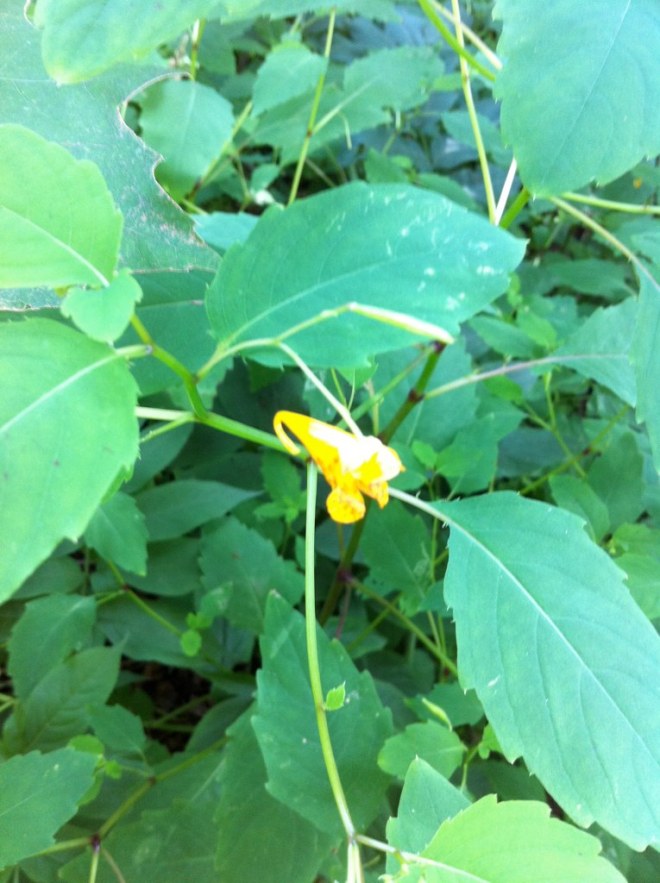 Yet another bad phone photo – sorry! This is Jewelweed, and Steve included this one on the tour because it is medicinal – it helps a lot with bug bites and poison ivy-afflicted skin. If you’ve come into contact with poison ivy and can smear some jewelweed juice on there pronto, word is that you may be able to stave off a rash. Steve also said we could soak jewelweed in witch hazel for a week or two, (in a sealed container in the fridge) then strain and use the liquid as a bug spray! Many kids were delighted by the seedpods of this plant, which literally explode when you touch them, casting their seeds out who knows how far. If you are very careful, you can get one in the palm of your hand, close your first, and when you open it you’ll have a handful of seeds (which were delicious – very nutty tasting.)
Yet another bad phone photo – sorry! This is Jewelweed, and Steve included this one on the tour because it is medicinal – it helps a lot with bug bites and poison ivy-afflicted skin. If you’ve come into contact with poison ivy and can smear some jewelweed juice on there pronto, word is that you may be able to stave off a rash. Steve also said we could soak jewelweed in witch hazel for a week or two, (in a sealed container in the fridge) then strain and use the liquid as a bug spray! Many kids were delighted by the seedpods of this plant, which literally explode when you touch them, casting their seeds out who knows how far. If you are very careful, you can get one in the palm of your hand, close your first, and when you open it you’ll have a handful of seeds (which were delicious – very nutty tasting.)
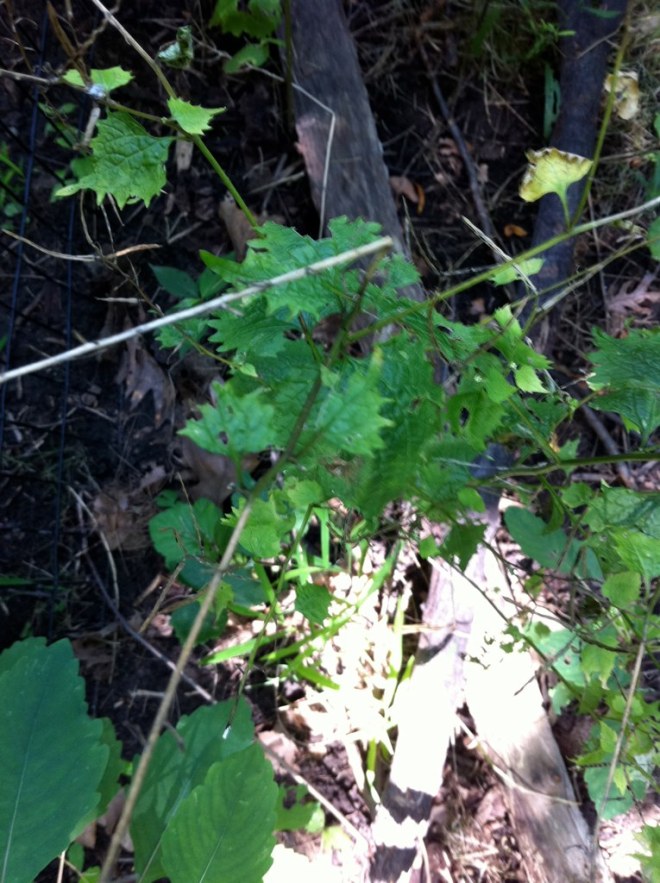 This is Garlic Mustard, and it is aptly named. The leaves were hot and garlicky – not everyone liked them, but I did!
This is Garlic Mustard, and it is aptly named. The leaves were hot and garlicky – not everyone liked them, but I did!
 This is Field Garlic – those long stems with an allium-like puff at the top – that’s what you want! MAN was that top part garlicky!
This is Field Garlic – those long stems with an allium-like puff at the top – that’s what you want! MAN was that top part garlicky!
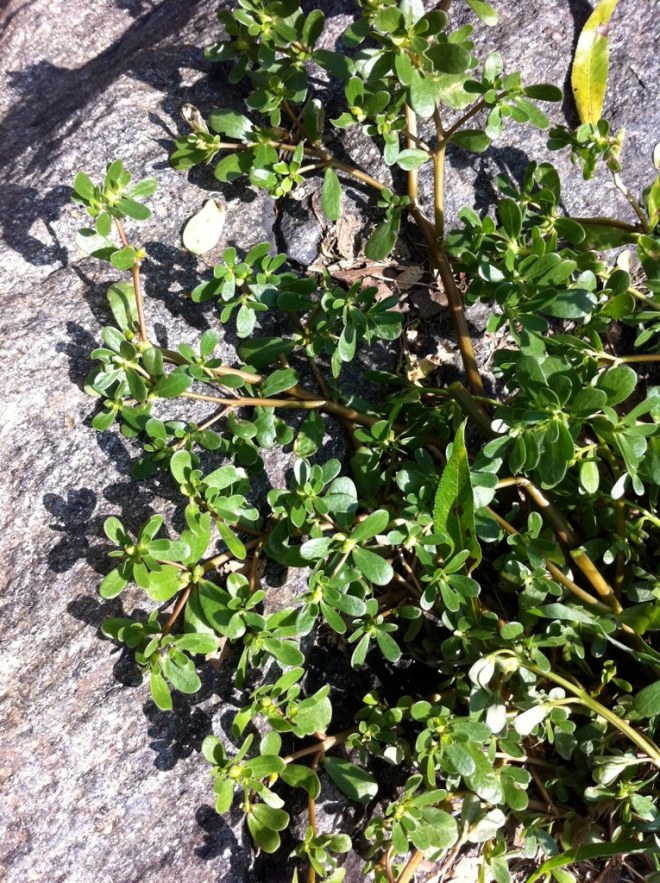 Steve didn’t point this one out to us but we saw some fellow foragers taking some cuttings and we got the scoop – it’s Purslane. I’ve never had it before, but I know some people add it to salads and love it. As with most wild edible plants, Purslane is supposed to be quite nutritious.
Steve didn’t point this one out to us but we saw some fellow foragers taking some cuttings and we got the scoop – it’s Purslane. I’ve never had it before, but I know some people add it to salads and love it. As with most wild edible plants, Purslane is supposed to be quite nutritious.
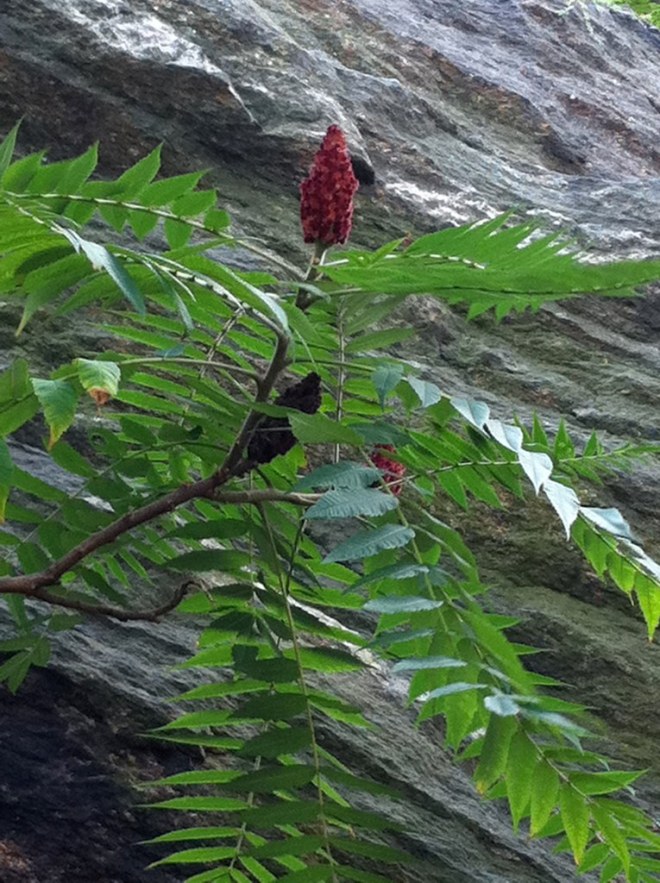 This tree is Sumac – not the poison kind, the edible kind! Those large, downy, reddish-brown “pods”, when dug into, reveal a portion of the plant that tastes very much like a tart lemon. Steve says it makes a fabulous lemonade. I just enjoyed it’s tart, citrusy taste on its own, but I bet he’s right.
This tree is Sumac – not the poison kind, the edible kind! Those large, downy, reddish-brown “pods”, when dug into, reveal a portion of the plant that tastes very much like a tart lemon. Steve says it makes a fabulous lemonade. I just enjoyed it’s tart, citrusy taste on its own, but I bet he’s right.
 Here’s some St. John’s Wort that Steve spotted. Not edible as is, but used in homeopathy for treating depression. I’ve never seen it in the wild before.
Here’s some St. John’s Wort that Steve spotted. Not edible as is, but used in homeopathy for treating depression. I’ve never seen it in the wild before.
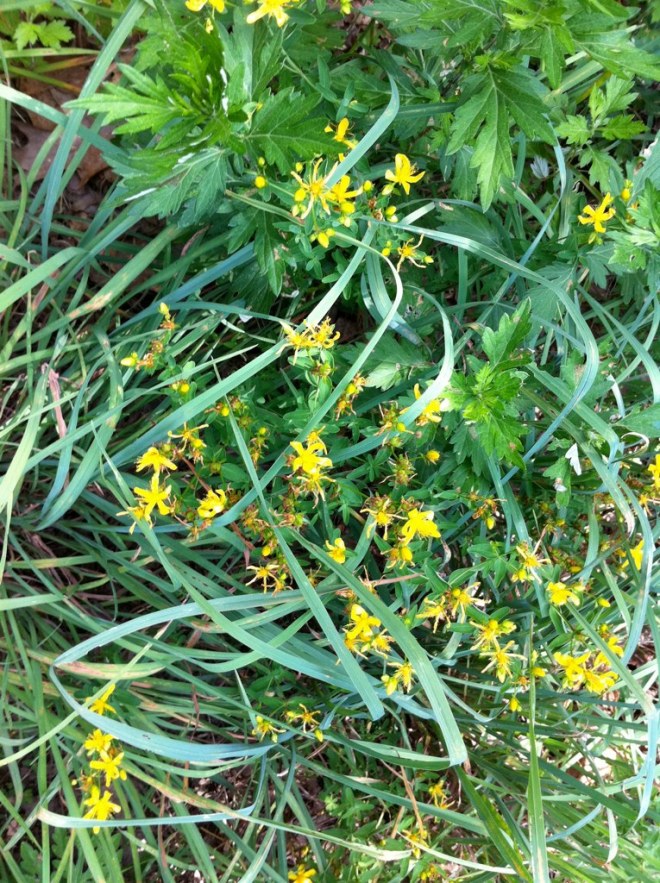 This is a closer shot taken above another St. John’s Wort plant.
This is a closer shot taken above another St. John’s Wort plant.
We saw and sampled a few other wild edibles that I didn’t manage to photograph:
Black Birch: the twigs from this tree are tasty to chew on – a very pleasant flavor! You can also boil them to make a tea – a strong tea will have an effect like aspirin.
Common Spicebush: a member of the Laurel family, the hard berries of this tree (shrub?) can be chopped or ground to make a spice similar in taste to allspice and used as a seasoning for quickbreads and sauces, etc.
Asiatic Dayflower: Perhaps my favorite edible plant of the day, this small plant with a gorgeous blue flower has leaves that taste EXACTLY like fresh, raw green beans! I couldn’t get enough! Fortunately I have this plant in my yard too. I’m including a photo from The Wildflowers of the West Village here so you can see a good photograph of the plant – in case you have it in your yard as well and want to give it a try. I’m hooked!
 a group of Asiatic Dayflowers – scrumptious! (Photo from http://www.thewildflowersofthewestvillage.com)
a group of Asiatic Dayflowers – scrumptious! (Photo from http://www.thewildflowersofthewestvillage.com)
All in all, an interesting, informative, and FUN day led by a friendly, knowledgeable, and entertaining host!
Here’s Steve playing the “Brillophone” – he had the kids (and some adults) amazed with his ability to hit every note on a scale by blowing out air and clapping it in front of his mouth – as we walked he would often “play” songs in between pointing out plants. As I said….highly entertaining. 😉
Thanks again, Mimi!


